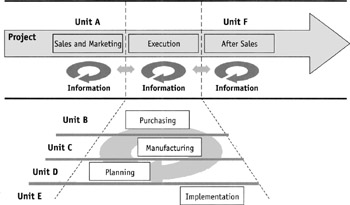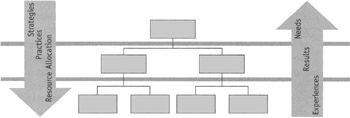Chapter 18: Project Companies and the Multi-Project Paradigm - A New Management Approach
|
Marko Arenius, Helsinki Institute of Physics
Karlos A. Artto, Ph.D.Helsinki University of Technology
Mika Lahti, M.Sc.Nokia
Jukka Meklin, M.Sc.Jippii Group Oyj
Introduction
The business environment of equipment and system suppliers has changed over the recent years. Project orientation has increased significantly in their businesses. Earlier, many of today's project-oriented companies delivered products that belonged to a single product or product family. The final project products were customized only to a limited extent to meet the requirements of specific customers. However, over the course of time companies have been forced to take even wider responsibility. For example, instead of simply selling a diesel engine to a power plant project, new customer demands may require that the diesel engine manufacturer take the responsibility for delivering the whole power plant. As projects serve as important vehicles for the whole business, mastering the management of manufacturing of single projects or products does not suffice. Today's management focus must cover the management of project-oriented business as a whole.
Kujala and Artto (2000) introduce the concept of extended project process. The extended project process is a result of extending the project process horizontally with pre-project and post-project phases. This is a key to integrating project management into managing corporate business. The extended project process divides delivery projects into three main phases: sales and marketing, execution, and after-sales phases. Names of these phases vary by companies, but a similar main phase structure can be found in many project supplier companies. In many cases each phase is organized to have responsible organizational units as their owners. The execution phase can be further divided into many subphases such as planning, manufacturing, purchasing, and so forth. These subphases, or works, are usually carried out by different lower-level organizational units. The phases of the overall extended process of a delivery project, with decision-making points included as phases, are (adapted from Artto et al. 2000; Cova 1998; and Holstius 1987): search, inquiry, bid preparation, bidding, contract (with contract negotiations), start-up, execution, commissioning, closeout, and after-sales.
The complicated organizational structure and the wide variety of organizational units involved in the project execution causes problems, as the divisional boundaries hamper information flows (see Figure 1). The results from previous empirical studies indicated that current organizational structures and practices do not correspond with the challenges of present-day project companies (Meklin et al. 1999; Artto et al. 1998). Learning from experiences and continuous improvement are important to all companies (Artto et al. 2001). However, in companies where activities are based on projects, effective learning schemes are particularly challenging to implement (Meklin et al. 1999).

Figure 1: Boundaries between Different Organizational Units across the Extended Project Process
The phenomenon of parallel projects serves as another challenge that renders knowledge management and business development in project companies. Most project companies are seeking means to control and manage an increasing number of parallel projects with overlapping contents and dependencies. This means not only that the company has to solve the resource allocation problem in a multi-project environment, but the company must also be capable of transferring information from one project to another in an effective manner. Furthermore, companies are implementing product development activities and they should be able to transfer new subcomponents and subsystems into practice to ongoing delivery projects. At the same time new product and process development operations need information and experiences from the project level. This requires that different organizational levels should receive and deliver information from each other according to a well-designed plan (Figure 2). However, concerning information transfer across organizational levels, a finding reported in Meklin et al. (1999) was that communication flows between the organizational levels are not always arranged in a systematic way. A challenge for the future studies and empirical applications of project management is the requirement for them to provide fine-grained knowledge on the information content at the various management levels in the overall organizational management framework.

Figure 2: Boundaries between Different Organizational Levels in Companies
Based on the previous discussion, project companies face two major challenges. First, management of organizational responsibilities, project structures, and knowledge sharing in the context of management of one single project, and second, organizing for responsibilities and knowledge sharing in the overall multiproject management system with integration of projects to the company business. Research, education, and business practices in project management have mainly focused on the management of one single project and have left many important organizational features of the multiproject paradigm without adequate attention. When a project takes place in a project company, the projects have not only external targets set by the customer but also internal targets set by the business requirements of the company. New management practices and tools have to be developed to cope with both targets. Another problem is that project management literature and standards do not define project processes that would provide a wide enough coverage of the extended project process with sales and after-sales aspects included. Instead, the implicit suggestion in project management literature is that project management processes are applied in the execution phase of the project only (International Organization for Standardization 10006 1997; Project Management Institute 1996).
This study contributes to the project management research by developing a three level approach to the management of a project company. Results of the conducted research demonstrated that there is a need to divide the management in the company into three levels: 1) business development, 2) business management, and 3) project management levels. These levels form a hierarchical structure with each level having a different managerial scope. This study puts forward practical recommendations on how to structure project-oriented companies in accordance with the proposed three level management approach. The results and recommendations were drawn from case studies conducted in Finnish project companies. The case studies were done during the research project "FIT-PRO—a product-oriented approach to industrial project management" (Meklin et al. 1999). The FIT-PRO research was carried out during 1998–1999. The case companies delivered industrial investment goods that were customized to meet the requirements of each individual operating environment and customer. The scope of the delivery projects in the case companies varied from the delivery of a single machine to the delivery of a turnkey project. The research data was collected mainly by interviewing project personnel of the case companies, but the interviews were supplemented with analyses and observations of delivered projects.
|
EAN: 2147483647
Pages: 207